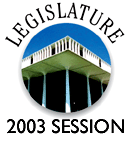
Debate over tax credits
persists for lawmakersState allowances can both help
and hurt Hawaii's economy
Of the dozens of bills passed by the 2003 Legislature, one of the more notable measures was one giving $75 million in tax credits over 10 years for the development of a world-class aquarium at Ko Olina Resort.
Meanwhile, one of Gov. Linda Lingle's more public defeats was her proposal to tighten the Act 221 high-technology tax credit.
Legislature Directory
Legislature Bills & Hawaii Revised Statutes
As the state plots its economic future, the debate over tax credits -- bad fiscal policy or a necessary economic driver -- is not likely to go away.
"I think there's a role for tax credits in economic development, but reliance on them is more of a Band-Aid than a fundamental solution," said Sumner La Croix, a professor and chairman of the Economics Department at the University of Hawaii.
Tax credits became a flash point of the session as lawmakers struggled to balance the need to spur economic growth against the state's fiscal reality.
The 2003 session started with an appeal from the Tax Review Commission for some accountability and a limit to what they called overly generous tax credits.
The Council on Revenues followed with a reduced forecast in the growth of tax revenues, blaming it on tax credits depleting state income.
Lingle's administration already has issued what is known as a tax information release, or TIR, meant to address administrative shortcomings that have been blamed for some companies -- moviemakers, in particular -- taking advantage of Act 221's broad wording to reap substantial tax breaks.
Act 221 was meant to stimulate investment in island high-technology businesses. Backers of qualifying companies can claim 100 percent tax credit over five years on their investment, essentially meaning the state foots the bill for the taxpayer's stake in the business.
State Tax Director Kurt Kawafuchi said he does not believe the TIR goes far enough to curb alleged abuses of the credit.
La Croix questioned whether there was a need for the state to provide a 100 percent credit.
"I could easily support a 10 or 20 or 30 percent tax credit, but a 100 percent tax credit means that people are going to invest for tax avoidance," he said. "The Act 221 credits are just far too generous."
Although the Senate backed Lingle's proposal to tighten the act, House lawmakers would not budge on their position to leave the law intact, saying Act 221 has done more to spur economic development than any measure in recent history.
Along with the Ko Olina bill, lawmakers also approved a measure extending the hotel construction and remodeling tax credit.
La Croix said he agrees that tax credits can be effective, but an overreliance on them also can deflect attention away from fundamental problems facing the state.
"I think the Ko Olina tax credit is a good example of the Legislature punting the issue of economic development," he said. "They really haven't been able to put together a constructive package for economic development on the Waianae-Makaha Coast."
"We'll get better economic development on the Waianae Coast if we have better schools, better roads," La Croix said. "This particular project is just an incredibly risky economic development."
Supporters of the Ko Olina tax credit note that it is a nonrefundable credit, meaning it can only be claimed if the taxpayer is turning a profit.
Jeff Stone, the developer behind Ko Olina, disagrees with critics who call the tax credit nothing more than a handout.
"We're building an attraction for the state with no risk to the state," he said. "We're basically doing what the state has done for other resort areas within our state.
"Take Waikiki, for example, or Kakaako -- the state has spent hundreds of millions, probably billions, putting in attractions and various things that drove the development and the economy for that region. ...
"If you want to drive an economic model, you must create an attraction."
